Culture and its impacts on hospitality industry Donna



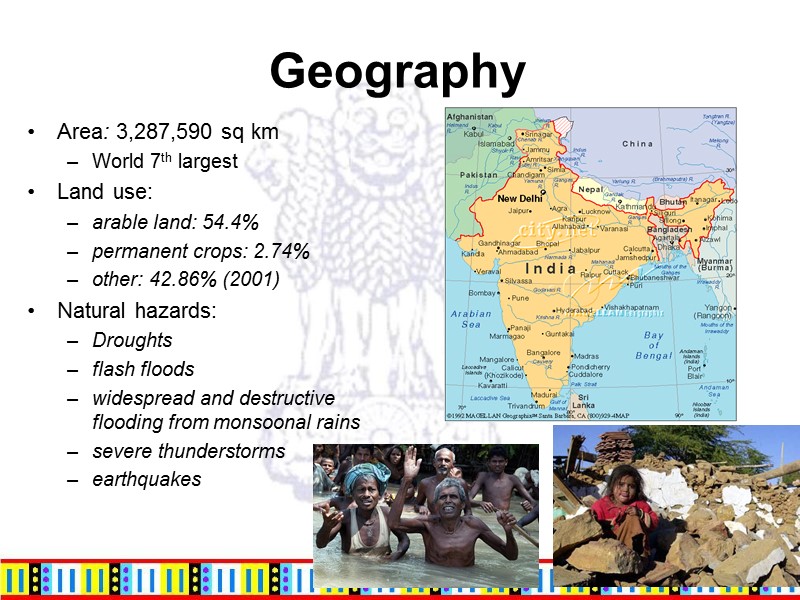


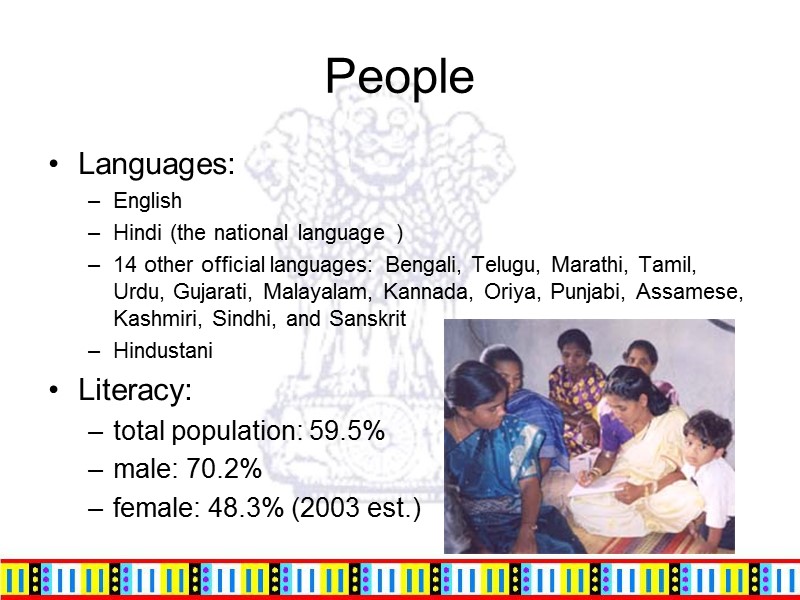















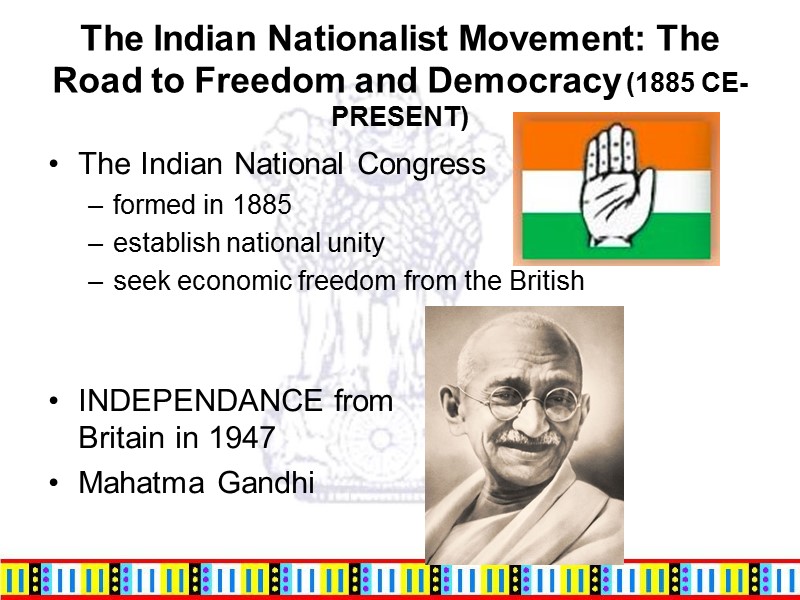







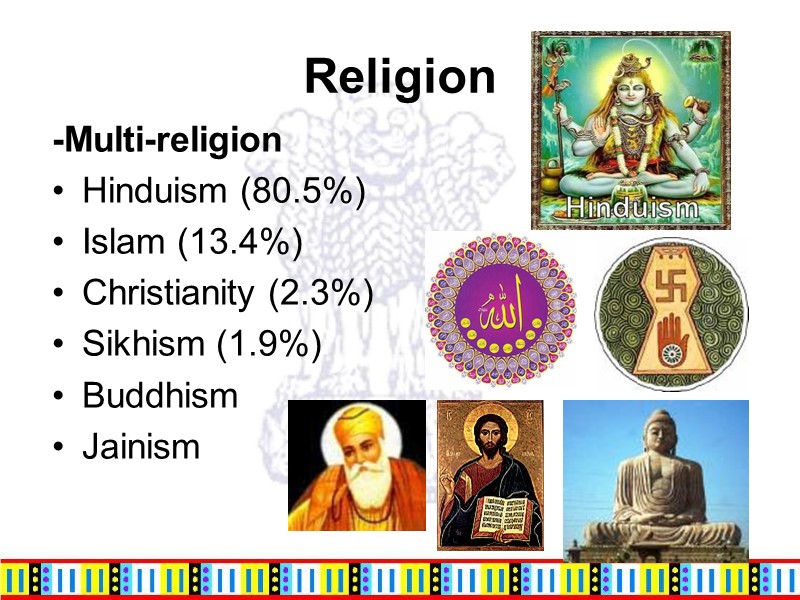






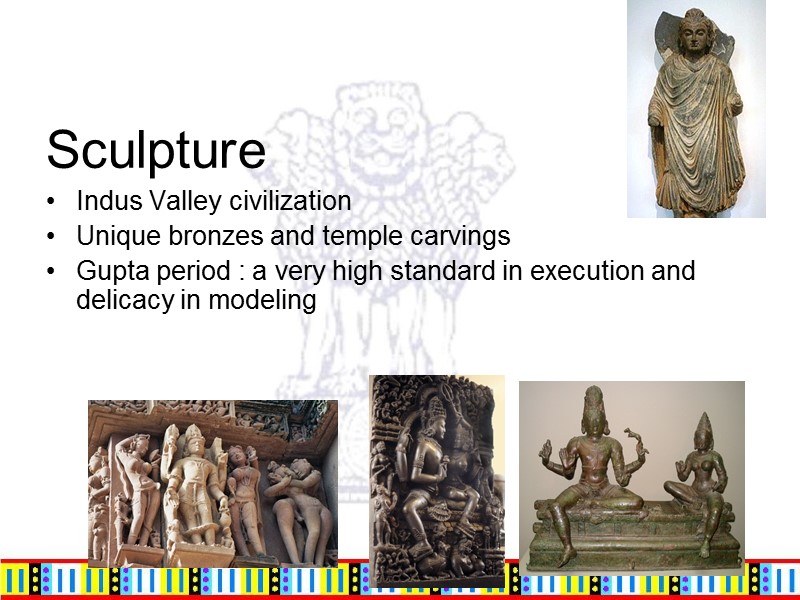




















28544-india,_hospitality_and_culture.ppt
- Количество слайдов: 57
 Culture and its impacts on hospitality industry Donna Eva Jackie Patty HTM 2118 Hospitality and Culture
Culture and its impacts on hospitality industry Donna Eva Jackie Patty HTM 2118 Hospitality and Culture
 Background Flag & Emblem
Background Flag & Emblem
 Geography Area: 3,287,590 sq km World 7th largest Land use: arable land: 54.4% permanent crops: 2.74% other: 42.86% (2001) Natural hazards: Droughts flash floods widespread and destructive flooding from monsoonal rains severe thunderstorms earthquakes
Geography Area: 3,287,590 sq km World 7th largest Land use: arable land: 54.4% permanent crops: 2.74% other: 42.86% (2001) Natural hazards: Droughts flash floods widespread and destructive flooding from monsoonal rains severe thunderstorms earthquakes
 People Population:1,065,070,607 (July 2004 est.) World second largest Population growth rate:1.44% (2004 est.) Total fertility rate:2.85 children born/woman (2004 est.)
People Population:1,065,070,607 (July 2004 est.) World second largest Population growth rate:1.44% (2004 est.) Total fertility rate:2.85 children born/woman (2004 est.)
 People Ethnic groups: Indo-Aryan 72%, Dravidian 25%, Mongoloid and other 3% (2000) Religions: Hindu 81.3% Muslim 12% Christian 2.3% Sikh 1.9 Buddhist, Jain, Parsi 2.5% (2000)
People Ethnic groups: Indo-Aryan 72%, Dravidian 25%, Mongoloid and other 3% (2000) Religions: Hindu 81.3% Muslim 12% Christian 2.3% Sikh 1.9 Buddhist, Jain, Parsi 2.5% (2000)
 People Languages: English Hindi (the national language ) 14 other official languages: Bengali, Telugu, Marathi, Tamil, Urdu, Gujarati, Malayalam, Kannada, Oriya, Punjabi, Assamese, Kashmiri, Sindhi, and Sanskrit Hindustani Literacy: total population: 59.5% male: 70.2% female: 48.3% (2003 est.)
People Languages: English Hindi (the national language ) 14 other official languages: Bengali, Telugu, Marathi, Tamil, Urdu, Gujarati, Malayalam, Kannada, Oriya, Punjabi, Assamese, Kashmiri, Sindhi, and Sanskrit Hindustani Literacy: total population: 59.5% male: 70.2% female: 48.3% (2003 est.)
 Government Government type: federal republic Capital: New Delhi Independence: 15 August 1947 (from UK) National holiday: Republic Day, 26 January (1950)
Government Government type: federal republic Capital: New Delhi Independence: 15 August 1947 (from UK) National holiday: Republic Day, 26 January (1950)
 Economy GDP - per capita: $2,900 (2004 est.) GDP - composition by sector: agriculture: 23.6% industry: 28.4% services: 48% (2002 est.) Population below poverty line: 25% (2002 est.) Agricultural products Industries
Economy GDP - per capita: $2,900 (2004 est.) GDP - composition by sector: agriculture: 23.6% industry: 28.4% services: 48% (2002 est.) Population below poverty line: 25% (2002 est.) Agricultural products Industries
 History over 4000 years never seriously took to documenting their history Indian history come from three sources: Literature Archeology Foreigner's Accounts
History over 4000 years never seriously took to documenting their history Indian history come from three sources: Literature Archeology Foreigner's Accounts
 The Indus Valley Civilization (2500 BCE-1600 BCE) Mohen-jodaro Harappa sati (suttee)
The Indus Valley Civilization (2500 BCE-1600 BCE) Mohen-jodaro Harappa sati (suttee)
 The Vedic Age: The Aryans and Alexander the Great (1500 BCE-332 BCE) religion classical language of Sanskrit architecture civilization Hinduism Warriors Priests Commoners The caste system Buddhism Jainism
The Vedic Age: The Aryans and Alexander the Great (1500 BCE-332 BCE) religion classical language of Sanskrit architecture civilization Hinduism Warriors Priests Commoners The caste system Buddhism Jainism
 The Vedic Age: The Aryans and Alexander the Great (1500 BCE-332 BCE) Alexander the Great defeated Porus in 326 B.C.E boosted trade contacts outside India
The Vedic Age: The Aryans and Alexander the Great (1500 BCE-332 BCE) Alexander the Great defeated Porus in 326 B.C.E boosted trade contacts outside India
 The Gupta Dynasty: The Golden Age of Indian Classicism (320-647 CE) Chandragupta II Literature Arts Sciences Poetry Romantic comedies Drama Fables Fairy tales e.g. Panchatantra “A Thousand and One Nights” “Aesop’s Fables”
The Gupta Dynasty: The Golden Age of Indian Classicism (320-647 CE) Chandragupta II Literature Arts Sciences Poetry Romantic comedies Drama Fables Fairy tales e.g. Panchatantra “A Thousand and One Nights” “Aesop’s Fables”
 The South Indian Kingdoms: Dynasties and Temple Culture (100 BCE-1565 CE) Cholas Pandyas Cheras Home to temples Meenakshi Amman Temple Nellaiappar Temple Nellaiappar Temple
The South Indian Kingdoms: Dynasties and Temple Culture (100 BCE-1565 CE) Cholas Pandyas Cheras Home to temples Meenakshi Amman Temple Nellaiappar Temple Nellaiappar Temple
 The Rajput Era: Clans, Campaigns and Chivalry (647-1296 CE) Warrior Rajput clans chivalry bravery passion devotion to war “Dark Age of India” rigid caste system child marriage polygamy persecution of Buddhists glorification of sati
The Rajput Era: Clans, Campaigns and Chivalry (647-1296 CE) Warrior Rajput clans chivalry bravery passion devotion to war “Dark Age of India” rigid caste system child marriage polygamy persecution of Buddhists glorification of sati
 Turkish Invasion and Rule: The Rise of Islam (997-1526 CE) Mahmud of Ghazni ISLAM Persian new literary genre: Persian literature New architecture: Mosques Mausoleums geometric floral
Turkish Invasion and Rule: The Rise of Islam (997-1526 CE) Mahmud of Ghazni ISLAM Persian new literary genre: Persian literature New architecture: Mosques Mausoleums geometric floral
 The Moghul Dynasty: Political Ambitious and the Impact of Islam (1526-1858 CE) Taj Mahal Red Fort City of Fatehpur Sikri 7 extraordinary rulers
The Moghul Dynasty: Political Ambitious and the Impact of Islam (1526-1858 CE) Taj Mahal Red Fort City of Fatehpur Sikri 7 extraordinary rulers
 The Moghul Dynasty: Political Ambitious and the Impact of Islam (1526-1858 CE) landscaped gardens, dress, food, and customs based on the teachings of the Koran E.g. pork and alcohol were forbidden surplus food always was to be shared with the poor.
The Moghul Dynasty: Political Ambitious and the Impact of Islam (1526-1858 CE) landscaped gardens, dress, food, and customs based on the teachings of the Koran E.g. pork and alcohol were forbidden surplus food always was to be shared with the poor.
 Early European Voyages: Leading to British Rule (1500-1885 CE) EUROPEANS Portuguese, French, Dutch, Danish, British Spices The Portuguese king commissioned Francis Xavier to India to christianize Indians and went about converting thousands with zealous evangelism The East India Company arrived India in 1608
Early European Voyages: Leading to British Rule (1500-1885 CE) EUROPEANS Portuguese, French, Dutch, Danish, British Spices The Portuguese king commissioned Francis Xavier to India to christianize Indians and went about converting thousands with zealous evangelism The East India Company arrived India in 1608
 The British Raj: From Trade to Dominion Mission schools and hospitals Missionaries study Indian languages Bible printed in Bengali, Hindi, Tamil, Telugu, and Marathi Grammar books and dictionaries in local language flourished official language - English vanishing of local languages Westernization spread of education Schools, universities, museums, libraries
The British Raj: From Trade to Dominion Mission schools and hospitals Missionaries study Indian languages Bible printed in Bengali, Hindi, Tamil, Telugu, and Marathi Grammar books and dictionaries in local language flourished official language - English vanishing of local languages Westernization spread of education Schools, universities, museums, libraries
 The British Raj: From Trade to Dominion Delhi, new capital in 1911, still houses the government today. Laws regulating inheritance, divorce, marriage and law of contracts were uniformly applied to all citizens of India. Sati was prohibited in 1829 Act of 1856 permitted widows to remarry, which was otherwise forbidden by Hindu law These somehow raised the social status of Indian women.
The British Raj: From Trade to Dominion Delhi, new capital in 1911, still houses the government today. Laws regulating inheritance, divorce, marriage and law of contracts were uniformly applied to all citizens of India. Sati was prohibited in 1829 Act of 1856 permitted widows to remarry, which was otherwise forbidden by Hindu law These somehow raised the social status of Indian women.
 The Indian Nationalist Movement: The Road to Freedom and Democracy (1885 CE-PRESENT) The Indian National Congress formed in 1885 establish national unity seek economic freedom from the British INDEPENDANCE from Britain in 1947 Mahatma Gandhi
The Indian Nationalist Movement: The Road to Freedom and Democracy (1885 CE-PRESENT) The Indian National Congress formed in 1885 establish national unity seek economic freedom from the British INDEPENDANCE from Britain in 1947 Mahatma Gandhi
 The Indian Nationalist Movement: The Road to Freedom and Democracy (1885 CE-PRESENT) Hindu-Muslim partition India Pakistan Migration Indo-Pakistani War terrorist attacks
The Indian Nationalist Movement: The Road to Freedom and Democracy (1885 CE-PRESENT) Hindu-Muslim partition India Pakistan Migration Indo-Pakistani War terrorist attacks
 India Today: Continuity and Technology Launched space satellites Economic liberalization Democracy has survived A country of unrealized potential Challenges: poverty oppression of women illiteracy
India Today: Continuity and Technology Launched space satellites Economic liberalization Democracy has survived A country of unrealized potential Challenges: poverty oppression of women illiteracy
 Impact on Culture Non-violent Religion never invaded any country in her history The British influence inspired western education and thoughts: Created a new educated class. Created a common language – English Inspired freedom and exchange of ideas Religious tolerance and freedom of worship
Impact on Culture Non-violent Religion never invaded any country in her history The British influence inspired western education and thoughts: Created a new educated class. Created a common language – English Inspired freedom and exchange of ideas Religious tolerance and freedom of worship
 Impact on Culture Religious tolerance and freedom of worship Hindus and Muslims live side by side but inter-religious marriages are rare Gandhi’s non-violence movement for freedom appealed to the civilized world Caste System almost all Indians are associated--are ranked
Impact on Culture Religious tolerance and freedom of worship Hindus and Muslims live side by side but inter-religious marriages are rare Gandhi’s non-violence movement for freedom appealed to the civilized world Caste System almost all Indians are associated--are ranked
 Introduction of India Culture Clothing Religion Food Customs Family Visual Arts Performing arts Recreation and Sports
Introduction of India Culture Clothing Religion Food Customs Family Visual Arts Performing arts Recreation and Sports
 Clothing related to local culture, religion and climate Men dhoti kurta sherwani Salwar kameez lungi kurta-paijama jeans
Clothing related to local culture, religion and climate Men dhoti kurta sherwani Salwar kameez lungi kurta-paijama jeans
 Women women’s clothing Sari/ Saree/ Shari Salwar kameez Muslim dress wearing pants and tee-shirts (influence of westernization)
Women women’s clothing Sari/ Saree/ Shari Salwar kameez Muslim dress wearing pants and tee-shirts (influence of westernization)
 Religion -Multi-religion Hinduism (80.5%) Islam (13.4%) Christianity (2.3%) Sikhism (1.9%) Buddhism Jainism
Religion -Multi-religion Hinduism (80.5%) Islam (13.4%) Christianity (2.3%) Sikhism (1.9%) Buddhism Jainism
 Varies from region to region Hindus do not eat beef Muslims do not eat pork or drink alcohol Vegetarian cuisine Meat for the non-vegetarians (mainly lamb, chicken, and fish) Meal, drink & snack
Varies from region to region Hindus do not eat beef Muslims do not eat pork or drink alcohol Vegetarian cuisine Meat for the non-vegetarians (mainly lamb, chicken, and fish) Meal, drink & snack
 Ingredients: mainly use herbs and spices Curry – “Pan -Asian” dish in favor of tea (most famous: Chai) Snack & appetizers Meal, drink& snack
Ingredients: mainly use herbs and spices Curry – “Pan -Asian” dish in favor of tea (most famous: Chai) Snack & appetizers Meal, drink& snack
 Custom Respect elderly and touch their feet for blessing Eat with fingers Always use right hand to eat Wash hands immediately after and before eating a meal Removes footwear while entering a private residence or temple Can't Say No Shaking hands
Custom Respect elderly and touch their feet for blessing Eat with fingers Always use right hand to eat Wash hands immediately after and before eating a meal Removes footwear while entering a private residence or temple Can't Say No Shaking hands
 Family About joy and sharing, love and patience Strong bonds with family members as well as relatives (Respect for elders) Sons are always more preferred over daughters Arranged marriages by parents Extremely low divorce rate with only 1.1% Most women do not own any property in their names
Family About joy and sharing, love and patience Strong bonds with family members as well as relatives (Respect for elders) Sons are always more preferred over daughters Arranged marriages by parents Extremely low divorce rate with only 1.1% Most women do not own any property in their names
 Women Status Have fraction of freedom Sends husband to the grocery store No freedom to pursue leisure activities Low participation in sports, music and arts Home maker
Women Status Have fraction of freedom Sends husband to the grocery store No freedom to pursue leisure activities Low participation in sports, music and arts Home maker
 Visual arts Painting Rock paintings Cave paintings New era of Indian art with Indian classical styles
Visual arts Painting Rock paintings Cave paintings New era of Indian art with Indian classical styles
 Sculpture Indus Valley civilization Unique bronzes and temple carvings Gupta period : a very high standard in execution and delicacy in modeling
Sculpture Indus Valley civilization Unique bronzes and temple carvings Gupta period : a very high standard in execution and delicacy in modeling
 Performing arts Music Multiples varieties of religious, folk, popular, pop, and classical music Carnatic (South India) and Hindustani music (North India) heavily influenced by Hindu texts Diverse traditions of folk music from different parts of the country
Performing arts Music Multiples varieties of religious, folk, popular, pop, and classical music Carnatic (South India) and Hindustani music (North India) heavily influenced by Hindu texts Diverse traditions of folk music from different parts of the country
 Dance Dance and ceremonies chief mode of entertainment Folk and classical forms Folk dance e.g. the bhangra of the Punjab, the bihu of Assam, the chhau of Jharkhand and Orissa Eight dance forms, many with narrative forms and mythological, devotional and spiritual elements.
Dance Dance and ceremonies chief mode of entertainment Folk and classical forms Folk dance e.g. the bhangra of the Punjab, the bihu of Assam, the chhau of Jharkhand and Orissa Eight dance forms, many with narrative forms and mythological, devotional and spiritual elements.
 What is India famous for? The palatial palaces, fantastic forts, impressive art and architecture, frescoes Havelis, magnificent temples amazing diversified culture
What is India famous for? The palatial palaces, fantastic forts, impressive art and architecture, frescoes Havelis, magnificent temples amazing diversified culture
 Domes Islamic design (arch)
Domes Islamic design (arch)
 Religious belief Indian color Let more tourists know about Indian arts Attract folk artist
Religious belief Indian color Let more tourists know about Indian arts Attract folk artist
 Tourism
Tourism
 People travel to explore the India culture and heritage e.g. visit the temples
People travel to explore the India culture and heritage e.g. visit the temples
 Mountaineering e.g. The Mighty Himalayan Mountains of India
Mountaineering e.g. The Mighty Himalayan Mountains of India
 Wildlife in India
Wildlife in India
 Camel Safari
Camel Safari
 Join the festivals e.g. the Dussehra Festival
Join the festivals e.g. the Dussehra Festival
 Medical Tourism
Medical Tourism
 Business traveling
Business traveling
 Night life: cultural shows No alcohol
Night life: cultural shows No alcohol
 Casino in GOA culture restriction?
Casino in GOA culture restriction?
 Dress code of the women travelers: as proper as you can Respect the senior travelers ( India respect the elderly)
Dress code of the women travelers: as proper as you can Respect the senior travelers ( India respect the elderly)
 Impact of Culture on India Food and beverage business What to eat when traveling to India? Spicy combat the flu virus healing and magical qualities more valuable than gold or precious stones trade of spices : an extraordinarily influential factor in history add flavor and nutrients to dishes without fat or calories offer significant health benefits
Impact of Culture on India Food and beverage business What to eat when traveling to India? Spicy combat the flu virus healing and magical qualities more valuable than gold or precious stones trade of spices : an extraordinarily influential factor in history add flavor and nutrients to dishes without fat or calories offer significant health benefits
 Indian Chai spiced milk tea made up of rich black tea and spices including whole cardamom pods pieces of stick cinnamon ginger cloves and pepper Herbal teas the oldest and most reliable form of supplementation soothing liquids provide hydration and a fresh herbal taste
Indian Chai spiced milk tea made up of rich black tea and spices including whole cardamom pods pieces of stick cinnamon ginger cloves and pepper Herbal teas the oldest and most reliable form of supplementation soothing liquids provide hydration and a fresh herbal taste
 Filtered coffee a favorite among South Indians very sweet, milky version of coffee Herbs used for medicines, perfumes and rituals
Filtered coffee a favorite among South Indians very sweet, milky version of coffee Herbs used for medicines, perfumes and rituals
 Reference Quinn, Brian. (1992-1993). World Travel Guide. : London,Columbus Press. P.403-421 Hotel Overseas Jul-Sep 2007 BMI India Tourism Report Q4 2009. : Business Monitor International LTD. Carol E.henderson (2002). Culture and Customs of India, : Westport,CT: Greenwood Press. India Chai Recipes, Retrieved October 17, 2009 from http://www.indianfoodsco.com/Recipes/hotbev_images/ChaiRecipes.htm India Chai Recipes, Retrieved October 17, 2009 from http://www.indianfoodsco.com/Recipes/hotbev_images/ChaiRecipes.htm Krannich,ronald L & Krannich, Caryl Rae (2000). Traveling smart. In The treasures and pleasure of India:Best of the Best (pp. 23-56). : Manassas Park, VA. Impact Publication.
Reference Quinn, Brian. (1992-1993). World Travel Guide. : London,Columbus Press. P.403-421 Hotel Overseas Jul-Sep 2007 BMI India Tourism Report Q4 2009. : Business Monitor International LTD. Carol E.henderson (2002). Culture and Customs of India, : Westport,CT: Greenwood Press. India Chai Recipes, Retrieved October 17, 2009 from http://www.indianfoodsco.com/Recipes/hotbev_images/ChaiRecipes.htm India Chai Recipes, Retrieved October 17, 2009 from http://www.indianfoodsco.com/Recipes/hotbev_images/ChaiRecipes.htm Krannich,ronald L & Krannich, Caryl Rae (2000). Traveling smart. In The treasures and pleasure of India:Best of the Best (pp. 23-56). : Manassas Park, VA. Impact Publication.

